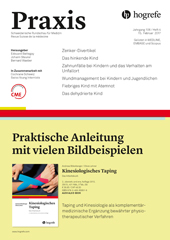Das hinkende Kind
Abstract
Zusammenfassung. Hinken ist ein häufiger Vorstellungsgrund in der pädiatrischen Praxis und stellt wegen der vielfältigen Differenzialdiagnosen, der teilweise schwierigen Anamnese und den möglicherweise sehr unspezifischen klinischen Befunden eine diagnostische Herausforderung dar. Die Kunst besteht darin, bei häufigen und selbstlimitierenden, harmlosen Krankheitsbildern (z.B. Coxitis fugax, Myositis) die diagnostischen Untersuchungen zurückhaltend einzusetzen und gleichzeitig potenziell schwerwiegende Ursachen (z.B. septische Arthritis, Epiphysiolysis capitis femoris) nicht zu verpassen. Eine sorgfältige Anamnese und körperliche Untersuchung grenzen die umfangreiche Liste der Differenzialdiagnosen entscheidend ein und helfen bei der Wahl allenfalls nötiger Zusatzuntersuchungen wie Bluttest oder bildgebender Verfahren.
Abstract. Limping is a common complaint in the pediatric acute care setting. The causes of limping are numerous, ranging from trivial to life-threatening. Obtaining a clear history can be challenging in the young patient, and clinical findings are often nonspecific. Keeping in mind an appropriate age-based differential diagnosis, unnecessary investigations should be avoided in common and benign conditions (e.g. transient synovitis, myositis), whereas more serious conditions (e.g. septic arthritis, slipped capital femoral epiphysis) should not be missed. A detailed history of the circumstances surrounding the limp and a careful physical examination help to identify possible causes and direct further investigations (e.g. imaging, blood studies)
Résumé. La boiterie est une plainte fréquente en pratique pédiatrique. Les causes en sont nombreuses, pouvant être triviales ou menaçantes sur le plan vital. L’obtention d’une anamnèse précise peut être difficile chez le jeune patient et les observations sur le plan clinique sont souvent non spécifiques. En gardant à l’esprit un diagnostic différentiel approprié prenant en compte l’âge, des investigations non nécessaires peuvent être évitées dans les situations communes et bénignes (par exemple en cas de synovite transitoire ou de myosite), alors que des conditions plus sérieuses (par exemple en cas d’arthrite septique ou de glissement de l’épiphyse de la tête fémorale) ne doivent pas être manquées. Une anamnèse détaillée des circonstances entourant la boiterie et un examen physique approfondi aident à identifier les causes possibles et à choisir les investigations supplémentaires (imagerie ou examens sanguins).
Bibliografie
: Overview of the causes of limp in children, UptoDate 2016. http://www.uptodate.com/contents/overview-of-the-causes-of-limp-in-children. Letzter Zugriff: 11.8.2016.
: Approach to the child with a limp. UptoDate 2016. http://www.uptodate.com/contents/approach-to-the-child-with-a-limp. Letzter Zugriff: 11.8.2016.
: Overview of hip pain in childhood. UptoDate 2016. http://www.uptodate.com/contents/overview-of-hip-pain-in-childhood. Letzter Zugriff: 11.8.2016.
: Hematogenous osteomyelitis in children: clinical features and complications. http://www.uptodate.com/contents/hematogenous-osteomyelitis-in-children-clinical-features-and-complications. Letzter Zugriff: 11.8.2016.
: The limping child. Pediatr Rev 2015; 36: 184–195.
: Utility of total lower extremity radiography investigation of nonweight bearing in the young child. Pediatrics 2008; 121: e817-e820.
: A multicenter case-control study on predictive factors distinguishing childhood leukemia from juvenile rheumatoid arthritis. Pediatrics 2006; 117: e840-e844.
, .: ACR Appropriateness Criteria® limping child – ages 0 to 5 years. J Am Coll Radiol 2012; 9: 545–553.
, .: The use of CRP within a clinical prediction algorithm for the differentiation of septic arthritis and transient synovitis in children. J Bone Joint Surg Br 2011; 93: 1556–1561.
, Ludwig S (Hrsg.): Textbook of pediatric emergency medicine. 7th Ed. Baltimore; Williams & Wilkins: 2015. 280–-.



